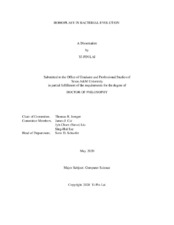| dc.description.abstract | This study addressed the following research goals: (1) a reevaluation of Lifelong Learning (LLL) scale’s reliability and validity measuring LLL skills, (2) reevaluation of Engineering Attitude Survey’s (EAS) reliability and validity of measuring students’ attitudes toward STEM fields, (3) effects of an evidence-based pedological (EBP) treatment on students’ LLL and engineering attitudes (EA) during a Computer-Aided Design course.
The appearance of homoplasy occurs when mutations are not derived from a common ancestor but arise independently in multiple branches of a phylogenetic tree. For bacteria, it suggests that genetic recombination events occur or positive selection exists during evolution, affecting the accuracy of phylogeny estimation. Without considering recombination, the reconstruction of phylogenetic trees based on an alignment of bacterial strains could be misleading. Hence, to better understand their true evolutionary histories among a bacterial population, it is essential to identify recombination breakpoints before estimating their phylogeny.
We developed an average compatibility ratio method with a permutation test, ptACR, to detect recombination breakpoints in a multiple sequence alignment without requiring a tree. We use a sliding window to evaluate the local compatibility of adjacent polymorphic sites to locate potential breakpoints and then assess the statistical significance of candidate breakpoints by applying a permutation test. We evaluate the performance of ptACR on both simulated and empirical datasets. The simulation results show that it has similar sensitivity but higher specificity and better F1 score compared to existing methods. Also, ptACR detects recombination events in a collection of clinical isolates of Mycobacterium avium and Staphylococcus aureus, and identifies boundaries of regions with statistical significance, where the adjacent regions exhibit distinct phylogenies.
For clonal species, since recombination is less likely to occur, the occurrence of homoplasy is a strong indicator of positive selection, such as antibiotic resistance. To identify mutations conferring resistance, genome-wide association studies are commonly applied to identify statistically significant associations between genotypes (polymorphisms) and phenotypes of interests (antibiotic resistance) across the entire genome. However, homoplasy is not well accounted for by most bacterial genome-wide association analyses, producing false positives or false negatives. Also, existing association methods usually use an individual site or group polymorphisms within a gene as genotypes without considering the frequency of evolutionary convergence and the mutation rate in different regions.
To better exploit homoplasy, we developed a two-phase evolutionary cluster-based convergence test (ECC) to identify regions harboring mutations under selection pressure associated with antibiotic resistance. In the first-phase step, we apply a Poisson distribution to detect regions exhibiting more changes (distinct mutational events) than expected by optimizing the grouping of SNPs within windows. Next, we test associations between the clustered regions and drug resistance using a hypergeometric distribution based on the concept of convergence test in the second phase. We model the distribution of changes occurring in the resistant or sensitive branches for each clustered region and compare it to the background. We evaluate the ECC method on empirical datasets of clinical isolates of Mycobacterium tuberculosis with seven phenotypes from drug susceptibility tests. Our two-phase evolutionary cluster-based convergence method is able to identify known resistant-associated sites within genes or intergenic regions corresponding to seven anti-tuberculous drugs. It also identifies two novel clustered regions in Rv2571 and Rv1830, potentially linked to isoniazid resistance. It improves the potential over existing methods for association tests to find more novel resistant-associated mutations, which will ultimately help in developing new antibiotic treatments.
In sum, we present two models for identifying genomic regions affected by recombination (ptACR) and clustered regions associated with antibiotic resistance driven by selection pressure (ECC) in bacterial genomes. | en |


